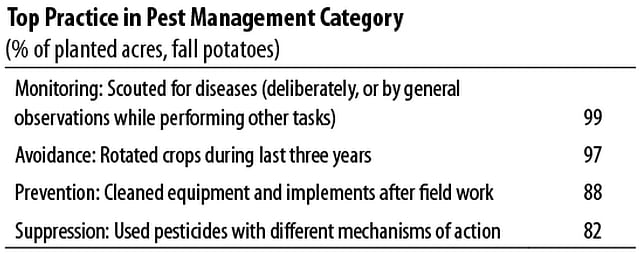Pesticides applied to fall potato planted acres in the United States, for 2014 crop year (begins after the 2013 harvest and ends after the 2014 harvest)
Source: USDA NASS
Primaire tabs
USDA publishes 2014 Chemical Use data for Fall Potatoes

The U.S. Department of Agriculture’s National Agricultural Statistics Service (NASS) thursday published the 2014 Agricultural Chemical Use survey data for corn and fall potatoes.
NASS collected data in the fall of 2014 from potato producers in 8 states representing 88 percent of the 936,900 acres of fall potato acres planted.
The information released includes on-farm fertilizer use, pesticide use, and pest management practices for these crops for 2014 crop year, beginning after the 2013 harvest and ending after the 2014 harvest.
Key findings for fall potatoes:
- As fertilizers, potato growers applied nitrogen to 99 percent and phosphate to 97 percent of planted fall potato acres, followed by potash at 90 percent.
- Farmers applied fungicides to 96 percent of potato planted acres, more than herbicides (91 percent) and insecticides (89 percent).
- Mitribuzin, the most widely applied active ingredient, is an herbicide that was applied to 75 percent of planted fall potato acres. The next most widely applied ingredients (chlorothalonil and mancozeb) are both fungicides.
Related information and data:
The survey asked growers to report on the practices they used to manage pests, including weeds, insects, and diseases. Fall potato growers reported practices in four categories:- Prevention practices involve actions to keep a pest population from infesting a crop or field.
- Avoidance practices use cultural measures to mitigate or eliminate detrimental effects of pests.
- Monitoring practices observe or detect pests through sampling, counting, or other forms of scouting.
- Suppression practices involve controlling or reducing existing pest populations to mitigate or eliminate crop damage.

Top Practices in Pest Management for fall potatoes in the United States in crop year 2014, by Category
Like to receive news like this by email? Join and Subscribe!
Get the latest potato industry news straight to your WhatsApp. Join the PotatoPro WhatsApp Community!
Sponsored Content
Sponsored Content
Sponsored Content
Sponsored Content






